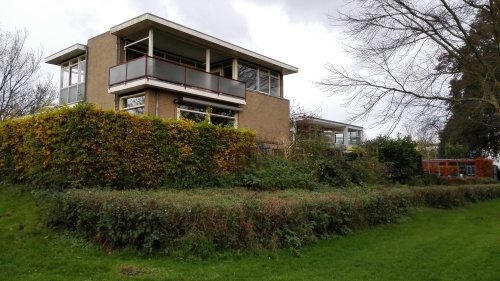This year it is 100 years since
De Stijl
was founded, the origin of the Dutch Modern Movement in Art (and Architecture). I cannot better describe this artistic movement than this quote from Wikipedia: “Proponents of De Stijl advocated pure abstraction and universality by a reduction to the essentials of form and colour; they simplified visual compositions to vertical and horizontal, using only black, white and primary colors.” The anniversary is celebrated in many Dutch cities with exhibitions, lectures and lots of merchandising. Utrecht is probably the frontrunner in this – home town of Gerrit Rietveld, one of the most iconic Stijl-members and designer of the WH listed
Rietveld-Schröder Huis
.

Two Rietveld villas from the rear
Yesterday I attended a symposium organized by the student society for Cultural Sciences at the Open University, titled 'De Stijl: a source of new art in the 20th century'. They had invited two inspiring speakers to introduce us to De Stijl in Utrecht painting and in Utrecht architecture. The work of Gerrit Rietveld was central to this of course, showing his development from painter to furniture maker to architect. The man of the simple and abstract compositions in primary colors started out his career with some very traditional painting, as shown in a quite skilfully executed depiction of Christ with a crown of thorns. This past is quite unknown and I have not even been able to find a photo of that painting on the internet.
For the afternoon program I had signed up for a bicycle tour 'along neighborhoods and buildings of Het Nieuwe Bouwen'. This took us to the suburbs in the south of Utrecht. At the Breitnerlaan, two private villas designed by Rietveld can be found. At number 11,
Huis Theissing
, the residents were ready to receive us. Due to its use of primary colors red, yellow and blue against a white background, the house can already be recognized from a distance as a work by Rietveld. Its interior is a surprise: the residents have furnished it completely modern, but in the spirit of Rietveld. The sliding panels that are so characteristic of the Rietveld-Schröder House were also present here, but these have been removed by the previous owner. The space is kept nice and tight by almost invisible closets. The garden has also been redone in style.

Rietveld villa Huis Theissing
The house of the neighbours is also designed by Rietveld and seems to be in a more original state. We were not allowed in there, so we got back on the bike. At the Robijnhof, Rietveld was finally able to dedicate himself to large-scale social housing (1958). At first sight, this appears to be a neighbourhood that can be seen in so many outlying areas of Dutch major cities, primarily intended to store as many people as possible. High and low-rise buildings alternate with lots of greenery and a common square in between. There are some details though at which you can recognize the hand of Rietveld: the lack of symmetry and the use of primary colors for example.
In one of the duplex houses, a model home, we were welcomed by a guide from the Centraal Museum. The museum has furnished this house with furniture from the fifties, made in the famous Utrecht Pastoe factory. My fellow visitors awe about the original granite countertop in its kitchen, the whole decoration really reminds me of my own apartment that dates from the early sixties. Only the Rietveld coat rack remains from the original interior design of the model home.

Appartments in the Robijnhof, designed by Rietveld
Visiting Rietveld’s legacy in Utrecht by bike is very convenient as the buildings lie somewhat spread out across the city. You can also do it under you own steam using this
itinerary
, and combine it with a tour of the Rietveld-Schröder Huis and the
Central Museum
in Utrecht which holds quite a bit of the furniture that he designed.



